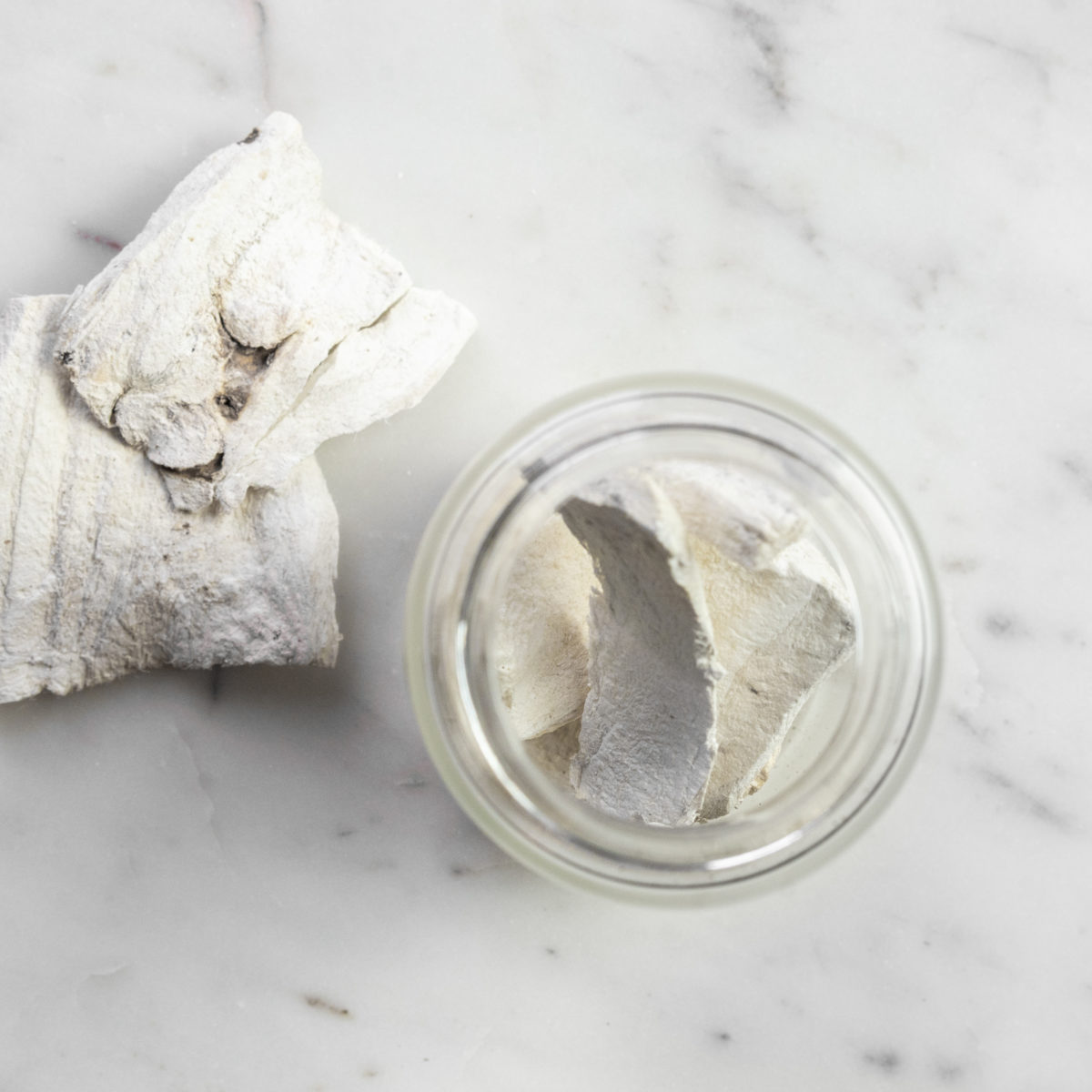
COMMON NAME (Chinese Name)
Kudzu (Gé Gēn)
BOTANICAL NAME
Pueraria lobata
COMMON NAMES
Kudzu; Japanese Arrowroot; East Asian Arrowroot; Chinese Pueraria
BOTANICAL NAMES
Pueraria lobata; Radix Pueraiae
USES
Kudzu tea has shown some promise for use in treating alcohol-related liver damage and helping people reduce dependence on or addiction to alcohol. That said, much more research is needed to really determine whether and to what degree drinking kudzu tea helps decrease alcohol cravings in humans. What we do know is that drinking kudzu tea can help lower blood alcohol levels (more quickly than normal) and shorten the length of alcohol-induced sleep*.
Additionally, drinking kudzu tea may help manage post-menopausal metabolic dysfunction and other common post-menopausal conditions, like obesity, fatigue, and cardiovascular disease. There is even some research to suggest that drinking kudzu tea may be a helpful accessory/accelerant for obesity treatment plans independent of menopausal status.
These health outcomes are mainly due to the potent anti-inflammatory and antioxidant properties of kudzu root decoctions. The antioxidant activity of kudzu tea, specifically, may make it useful in preventing some physical evidence of aging, like growing gray hair and getting wrinkles. What’s more, it may also help prevent and slow the progression of various cognitive and physical conditions associated with aging, like Alzheimer’s disease and osteoporosis. Drinking kudzu tea or taking kudzu supplements may also have some effect on improving exercise performance (including cardiovascular and muscular endurance).
Kudzu root is categorized in Chinese medicine as a cool, acrid diaphoretic herb that releases the exterior. It is cool, spicy, and sweet, and goes to the Spleen and Stomach channels.
*Drinking kudzu tea will not immediately cause someone to become fully sober, nor should it be used to try to reverse acute alcohol poisoning; people who are showing signs of alcohol poisoning or who have lost consciousness due to alcohol ingestion need immediate, professional medical care.
PREPARATION & ADMINISTRATION
Traditional medicinal uses involve making a tea (hot water decoction or infusion) using the dried leguminous roots of the kudzu plant. More novel applications call for using the flowers as well as or instead of the roots. The whole, dried roots are often available for purchase and at-home decoction, though powders, pills, and ethanol-based extractions are also occasionally available. Sometimes the related plant species, Pueraria thomsonii, is substituted for authentic kudzu supplements. Though not actively harmful, this substitution is problematic because Pueraria thomsonii has noticeably fewer medicinal benefits.
PRECAUTIONS
You should consult with a certified herbalist, physician or other qualified healthcare professional before taking kudzu. Because it may have some effect on cardiovascular function, people who have or are at high risk for cardiovascular health conditions should not drink kudzu tea, or they should get explicit approval from their physician before doing so. This is also true for people who have liver disease, metabolic disorders, or a history of problems with their blood sugar. Though kudzu tea and other supplements are largely considered safe for healthy adults, it is always important to consult a physician before adding a new supplement to your routine.
REFERENCES
Bebrevska, Lidiya, Kenne Foubert, Nina Hermans, Shyama Chatterjee, Eric Van Marck, Guido De Meyer, Arnold Vlietinck, Luc Pieters, and Sandra Apers. “In Vivo Antioxidative Activity of a Quantified Pueraria Lobata Root Extract.” Journal of Ethnopharmacology. Elsevier, September 30, 2009. https://www.sciencedirect.com/science/article/abs/pii/S0378874109005996.
Jiang, Ren-Wang, et al. “A Comparative Study on Aqueous Root Extracts of Pueraria Thomsonii and Pueraria Lobata by Antioxidant Assay and HPLC Fingerprint Analysis.” Journal of Ethnopharmacology, vol. 96, no. 1-2, 2005, pp. 133–138., doi:10.1016/j.jep.2004.08.029.
Jo, Seong Jin, et al. “Efficacy and Safety of Pueraria Lobata Extract in Gray Hair Prevention: A Randomized, Double-Blind, Placebo-Controlled Study.” Annals of Dermatology, Korean Dermatological Association; The Korean Society for Investigative Dermatology, May 2013, www.ncbi.nlm.nih.gov/pmc/articles/PMC3662917/.
Koirala, Prashamsa, et al. “Comparative Evaluation of the Antioxidant and Anti-Alzheimer’s Disease Potential of Coumestrol and Puerarol Isolated from Pueraria Lobata Using Molecular Modeling Studies.” Molecules, vol. 23, no. 4, 2018, p. 785., doi:10.3390/molecules23040785.
Lee, Yoon Hee, Bora Jin, Sunghyun Lee, Jin-Young Oh, Jungbin Song, Donghun Lee, Young-Sik Kim, and Hocheol Kim. “A Herbal Formula HT051, a Combination of Pueraria Lobata and Rehmannia Glutinosa, Prevents Postmenopausal Obesity in Ovariectomized Rats.” Evidence-Based Complementary and Alternative Medicine 2017 (2017): 1–11. https://doi.org/10.1155/2017/8641535.
Koo, et al. “The Suppressive Effect of Pueraria Lobata Root Extract and Its Biotransformed Preparation against Skin Wrinkle Formation.” Korean Journal of Plant Res, vol. 30, no. 3, 2017.
Lim, Dong, Changho Lee, In-Ho Kim, and Yun Kim. “Anti-Inflammatory Effects of Total Isoflavones from Pueraria Lobata on Cerebral Ischemia in Rats.” Molecules 18, no. 9 (2013): 10404–12. https://doi.org/10.3390/molecules180910404.
Oh, Ji Hong, Seon-Eun Baek, Won-Yung Lee, Ji Yun Baek, Tuy An Trinh, Do Hwi Park, Hye Lim Lee, Ki Sung Kang, Chang-Eop Kim, and Jeong-Eun Yoo. “Investigating the Systems-Level Effect of Pueraria Lobata for Menopause-Related Metabolic Diseases Using an Ovariectomized Rat Model and Network Pharmacological Analysis.” Biomolecules 9, no. 11 (2019): 747. https://doi.org/10.3390/biom9110747.
Pizzorno, Joseph E., Michael T. Murray, and Herb Joiner-Bey. “Alcohol Dependence.” The Clinician’s Handbook of Natural Medicine (THIRD EDITION). Churchill Livingstone, December 3, 2015. https://www.sciencedirect.com/science/article/pii/B9780702055140000129.
Prasain, Jeevan K., Ning Peng, Rajani Rajbhandari, and J. Michael Wyss. “The Chinese Pueraria Root Extract (Pueraria Lobata) Ameliorates Impaired Glucose and Lipid Metabolism in Obese Mice.” Phytomedicine. Urban & Fischer, November 2, 2012. https://www.sciencedirect.com/science/article/abs/pii/S0944711312003534.
Xiong, Yu, Yuqing Yang, Jin Yang, Hongyan Chai, Ying Li, Jing Yang, Ziming Jia, and Zhengrong Wang. “Tectoridin, an Isoflavone Glycoside from the Flower of Pueraria Lobata, Prevents Acute Ethanol-Induced Liver Steatosis in Mice.” Toxicology. Elsevier, July 15, 2010. https://www.sciencedirect.com/science/article/pii/S0300483X10002866.
Yeh, Tzu-Shao, et al. “Supplementation with Soybean Peptides, Taurine, Pueraria Isoflavone, and Ginseng Saponin Complex Improves Endurance Exercise Capacity in Humans.” Journal of Medicinal Food, vol. 14, no. 3, 2011, pp. 219–225., doi:10.1089/jmf.2010.1096.
Zhu, Weili, Yinan Zhang, Yingjie Huang, and Lin Lu. “Chinese Herbal Medicine for the Treatment of Drug Addiction.” International Review of Neurobiology. Academic Press, March 25, 2017. https://www.sciencedirect.com/science/article/pii/S0074774217300223.
